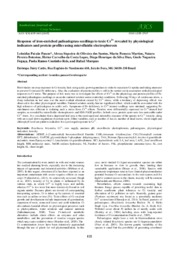Response of iron-enriched palisadegrass seedlings to toxic Cr3+ revealed by physiological indicators and protein profiles using microfluidic electrophoresis.
Response of iron-enriched palisadegrass seedlings to toxic Cr3+ revealed by physiological indicators and protein profiles using microfluidic electrophoresis.
Author(s): PASSOS, L. P.; SANTOS, A. S. de O. dos; MARTINS, M. F.; BOTEZINE, N. P.; LOPES, H. C. da C.; DIAS, D. H. da S.; FOGAÇA, G. N.; REIS, P. R. C.; MARQUES, R.
Summary: Most studies on crop responses to Cr toxicity lack using acidic growing medium in order to maximize Cr uptake and taking measures to prevent Cr-induced Fe deficiency. Also, the evaluation of protein profiles is still to be carried out in association with physiological responses to Cr stress. The purpose of this study was to investigate the effects of Cr3+ on the physiology and protein profiles of Feenriched palisadegrass seedlings in an acidic nutrient solution under controlled conditions. Following 30 days of continuous stress, a sharp reduction in leaf area was the most evident alteration caused by Cr3+ stress, while a tendency of depressing effects was observed in the other physiological variables. Nutrient solution acidity had no significant effect, which could be associated with the high tolerance of palisadegrass to acidic soils. Symptoms of Fe deficiency in Cr3+ -treated seedlings were minimal, suggesting Feenrichment was efficient in isolating such a stress from Cr3+ effects. Proteins were differentially expressed in Cr3+ -treated leaf samples, as revealed by microfluidic electrophoresis and SDS-PAGE profiles. In both cases, protein spots were less noticeable under Cr3+ stress. It is concluded that a depressed leaf area is the most rapid and detectable response of the species to Cr3+ toxicity, along with an overall down-regulation of protein spots. Other variables, such as number of leaves, number of dead leaves, shoot length and chlorophyll level are putative indicators for a prolonged exposure to Cr3+.
Publication year: 2015
Types of publication: Journal article
Unit: Embrapa Dairy Cattle
Observation
Some of Embrapa's publications are published as ePub files. To read them, use or download one of the following free software options to your computer or mobile device. Android: Google Play Books; IOS: iBooks; Windows and Linux: Calibre.
Access other publications
Access the Agricultural Research Database (BDPA) to consult Embrapa's full library collection and records.
Visit Embrapa Bookstore to purchase books and other publications sold by Embrapa.

